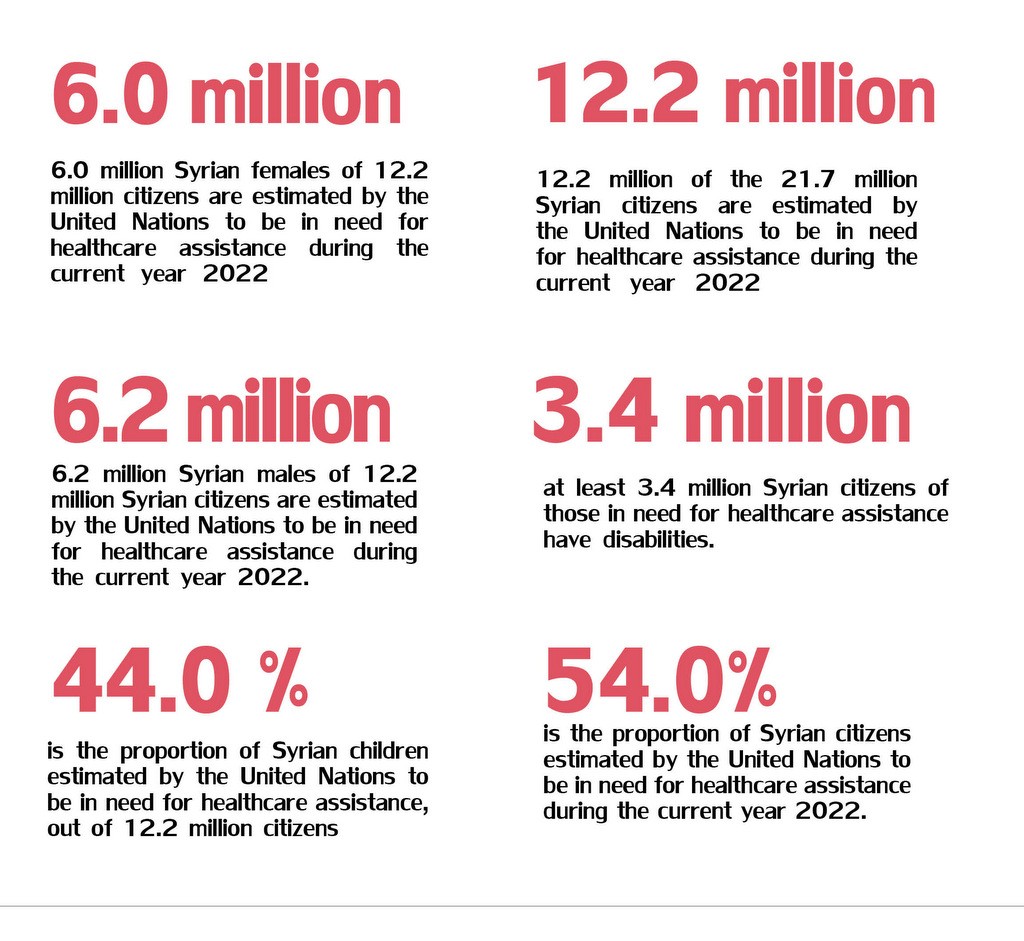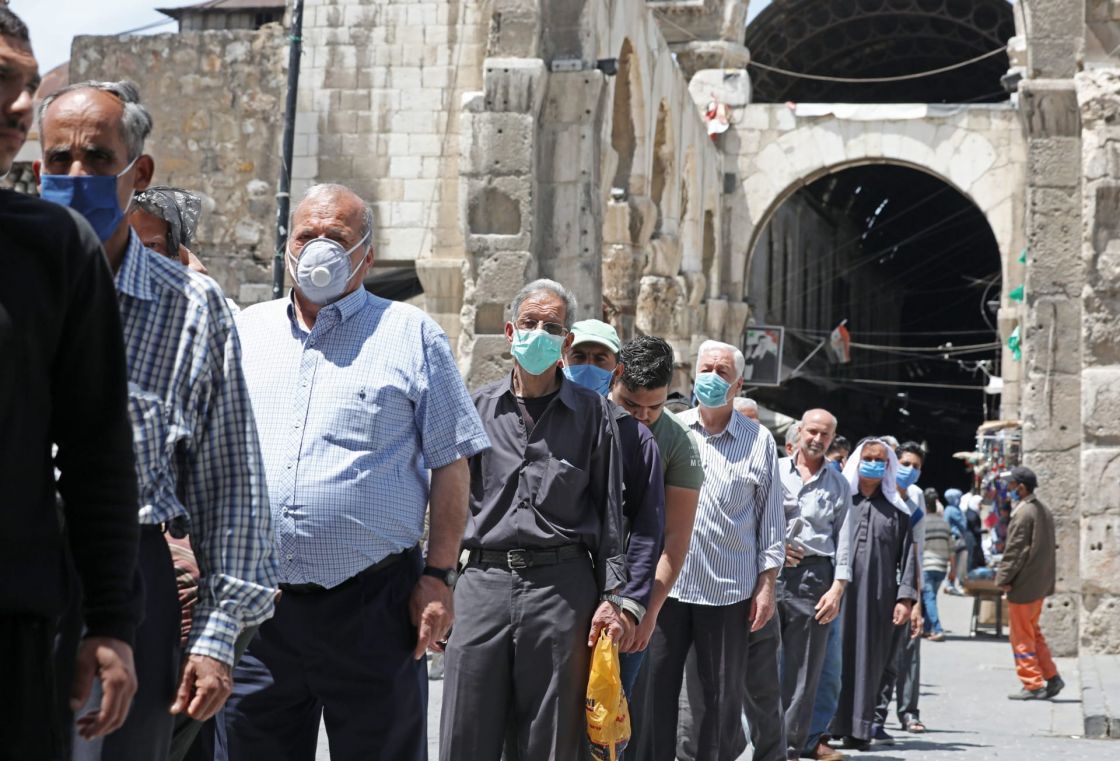- Articles
- Posted
More than Half of the Syrian People are Now in Need for Healthcare Assistance
The Syrian healthcare sector is facing crises and chronic problems that are reflecting in the lack of the availability and quality of healthcare services across the country. Alongside the inability to determine the real effects of the spread of Coronavirus in the country, in absence of reliable government figures on cases and deaths, disruption in healthcare services and systems continues. This is not only because of the spread of the virus and the conditions of the Syrian crisis, but mainly because of the decline in government expenditure on healthcare sector, which continues to reduce constantly and rapidly.
Over the past year, a combination of factors has led to exacerbating the disruption of healthcare services in the country. Besides the Covid-19 pandemic, security incidents that have occurred – especially in the northeast, northwest, and south of the country – have led to the decommissioning of many healthcare facilities, and also to the displacement of about 140000 Syrian citizens who need healthcare services.
According to the estimations of the World Health Organization, five Syrian governorates (Al Raqqa, Deir ez-Zur, Hama, Homs, and rural Damascus) are governorates with the ealargest number of areas considered to be the most dangerous on the level of healthcare.
Covid-19 Pandemic and Vaccine Entitlement
As of February, the total number of vaccines received by Syria through the Global Access to COVID-19 Vaccines Initiative (COVAX) has reached 8,352,740 doses, in addition to 2,713,640 doses that were received by Syria through bilateral agreements. These allocations combined are enough to cover about 38% of the population, and in the near future, the country is expected to receive approximately 3.7 million doses of vaccines through COVAX, which is enough to cover an additional 18.2% of the population.

12.2 Million are in Need for Healthcare Assistance
The deterioration in the healthcare sector does not need much evidence, as it is enough to point out to the fact that 12.2 million of the 21.7 million Syrian citizens are estimated by the United Nations to be in need for healthcare assistance during the current year 2022. That is, more than half of the Syrian population (54%) are now in need for healthcare assistance. Among these, 6 million are females (49%) and 6.2 million are males (51%). As for children, there are at least 44% from the total ones in need, and of the 12.2 million, at least 3.4 million citizens (28%) have disabilities.
The Most Affected Governorates
According to the estimates of the United Nations, the governorates of Al-Hasaka, Al-Raqaa, As Suwayda, and Deir ez Zur have shown fewer healthcare capabilities, as these governorates are suffering more from the unavailability and high costs of healthcare services. Nonetheless, healthcare situation in other governorates is not any better, as high-density population cities are suffering from lack of clean water supplies, which has aggravated the risk of infectious diseases. In addition to, the long waiting hours in healthcare facilities, which have significantly increased during the past year.
Government Expenditure in 2021 is One-Third the Expenditure in 2011
Despite official statements that kept making Syrian people feel indebted with government expenditure on healthcare sector, behind the increasing expenditure figures (in Syrian pounds) lies the truth of the severe decline in expenditure if compared to the dollar. It is true that government discretionary spending on healthcare sector has increased from 11 billion Syrian pounds in 2011 to 38 billion Syrian pounds in 2015, then to 99 billion during the past year 2021, however, the same discretionary expenses were decreasing if compared to the dollar, according to the exchange rate at the Central Bank of Syria. (Discretionary spending means the appropriations the government allocates in its budget to spend on the sector, however, this spending is not actual spending, as actual spending is only available in the closing of budget calculations that have not been issued for years). Discretionary expenses have decreased from $248 million in 2011, to $170 million in 2015, then severely declined in 2021, as they have not exceeded $80 million. That is, discretionary expenses in 2021 did not exceed 31.7% of the discretionary expenses in 2011.

Per Capita Government Expenditure on Healthcare; A Disastrous Decline
The United Nations estimate Syria’s population at about 21.7 million. By dividing the government’s discretionary sum that it allocated in its 2021 budget, i.e., 79,058,690 million dollars by the number of citizens, we can find the annual share of the Syrian individual from the government’s discretionary expenses on healthcare. That way, the share of healthcare per capita according to 2021 budget amounts to approximately $3.6 a year! We will not compare this disastrous share with other countries so that numbers do not look astronomical (the global average is about $554 annually), but we will only compare them with the data of 2019, where the share of healthcare per capita was $33 annually, and with the data of 2010 where the share was $42 annually. In other words, the share per capita from the total government’s discretionary spending on healthcare in 2021 is close to the share per capita during one month of 2019, i.e., it has declined by 89% during only two years.
Severe Shortage is Pervading the Sector
As mentioned before, the decline in healthcare sector did not begin with the outbreak of the crisis in the country, rather it preceded it. A quick look at the figures in the Central Bureau of Statistics is enough to prove this, as the number of government hospitals in Syria have decreased from 150 hospitals in 2002 to 113 hospitals in 2019. Moreover, the country has lost nearly 10 thousand government hospital beds during the same period, as the number of government hospital beds have decreased from 30,094 beds in 2002 to 20,994 in 2019.
Finally, it should be noted at last that the share of the Syrian healthcare sector in general, in the Syrian budget estimates, is originally an exceptional share given its small amount. Healthcare expenses are equivalent to only 1.1% of total expenditure in the state budget of 2021, which is a historically low percentage in the country, as it did not exceed 6.8% of 2019 budget and 7.5% of 2003 budget.
As with other countries, they allocate an average of 15% of their budgets to spend on healthcare sector. According to previous estimates by Kassioun, this percentage in Iran is 22%, in Turkey 10%, and in the European Union it is close to 16% of government expenditure allocations.



